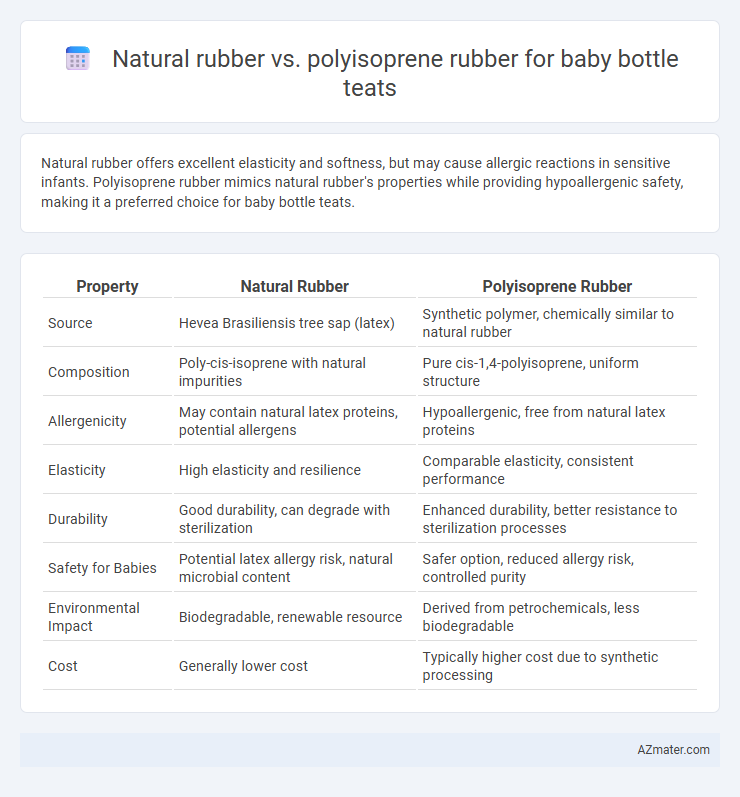Natural rubber offers excellent elasticity and softness, but may cause allergic reactions in sensitive infants. Polyisoprene rubber mimics natural rubber's properties while providing hypoallergenic safety, making it a preferred choice for baby bottle teats.
Table of Comparison
| Property | Natural Rubber | Polyisoprene Rubber |
|---|---|---|
| Source | Hevea Brasiliensis tree sap (latex) | Synthetic polymer, chemically similar to natural rubber |
| Composition | Poly-cis-isoprene with natural impurities | Pure cis-1,4-polyisoprene, uniform structure |
| Allergenicity | May contain natural latex proteins, potential allergens | Hypoallergenic, free from natural latex proteins |
| Elasticity | High elasticity and resilience | Comparable elasticity, consistent performance |
| Durability | Good durability, can degrade with sterilization | Enhanced durability, better resistance to sterilization processes |
| Safety for Babies | Potential latex allergy risk, natural microbial content | Safer option, reduced allergy risk, controlled purity |
| Environmental Impact | Biodegradable, renewable resource | Derived from petrochemicals, less biodegradable |
| Cost | Generally lower cost | Typically higher cost due to synthetic processing |
Introduction to Baby Bottle Teat Materials
Natural rubber offers excellent elasticity and softness, making it a popular choice for baby bottle teats due to its comfort and natural feel. Polyisoprene rubber provides similar hypoallergenic properties and durability while being free from proteins found in natural rubber, reducing the risk of allergic reactions. Both materials ensure flexibility and safety, but polyisoprene is often preferred for sensitive infants needing a synthetic alternative.
What is Natural Rubber?
Natural rubber, derived from the latex sap of the Hevea brasiliensis tree, is a biodegradable elastomer prized for its excellent elasticity, resilience, and safety in baby bottle teats. Its molecular structure consists primarily of cis-1,4-polyisoprene, contributing to its superior softness and flexibility compared to synthetic alternatives. Natural rubber's hypoallergenic properties and natural resistance to punctures make it a preferred material for infant feeding products, ensuring comfort and safety for babies.
What is Polyisoprene Rubber?
Polyisoprene rubber is a synthetic alternative to natural rubber, designed to mimic its elasticity and softness while reducing allergenic proteins, making it ideal for baby bottle teats. It offers superior hypoallergenic properties and greater purity, which minimizes the risk of latex allergies in infants. Polyisoprene rubber maintains excellent durability and flexibility, ensuring safety and comfort during feeding.
Material Composition Comparison
Natural rubber baby bottle teats consist primarily of natural cis-1,4-polyisoprene derived from latex harvested from Hevea brasiliensis trees, offering elasticity and biodegradability. Polyisoprene rubber teats, synthesized chemically, mimic the molecular structure of natural rubber but provide improved purity by eliminating proteins that can cause allergies. Material composition differences impact allergenic potential and durability, with polyisoprene favored for hypoallergenic properties and consistent performance.
Safety and Allergenicity
Natural rubber contains proteins that can cause allergic reactions in sensitive infants, posing a safety concern for baby bottle teats. Polyisoprene rubber, being a synthetic alternative, offers comparable elasticity and softness without the allergenic proteins, significantly reducing the risk of latex allergy. This makes polyisoprene a safer choice for infants prone to allergies or with sensitive skin.
Durability and Longevity
Natural rubber baby bottle teats exhibit superior elasticity and softness but tend to degrade faster due to protein content causing allergenic reactions and accelerated wear. Polyisoprene rubber, a synthetic alternative, mimics natural rubber's flexibility while offering enhanced durability and resistance to oxidation and UV exposure, resulting in longer-lasting teats. The absence of natural proteins in polyisoprene significantly reduces allergenic risks and maintains teat integrity over extended use, making it a preferable choice for longevity.
Flexibility and Comfort for Babies
Natural rubber offers exceptional flexibility and softness, mimicking the natural feel of a mother's skin, which enhances comfort for babies during feeding. Polyisoprene rubber, while also flexible and hypoallergenic, provides a smoother, latex-free alternative that reduces the risk of allergies without compromising softness. Both materials ensure effective teat elasticity, but natural rubber excels in natural softness, whereas polyisoprene prioritizes allergen-free comfort for sensitive infants.
Cleaning and Maintenance
Natural rubber baby bottle teats require thorough cleaning to prevent residue buildup and potential allergen risks due to their porous structure. Polyisoprene rubber offers easier maintenance as its synthetic composition resists dirt accumulation and withstands sterilization without degrading. Choosing polyisoprene reduces cleaning frequency and prolongs teat durability while maintaining safety standards.
Environmental Impact
Natural rubber for baby bottle teats offers a renewable resource derived from rubber trees, promoting sustainable harvesting and biodegradability, which reduces long-term environmental waste. Polyisoprene rubber, although synthetic, provides similar elasticity but relies on petrochemical sources, contributing to fossil fuel depletion and higher carbon emissions during production. Choosing natural rubber supports eco-friendly practices by minimizing synthetic polymer pollution and enhancing end-of-life compostability in baby care products.
Choosing the Right Teat Material for Your Baby
Natural rubber and polyisoprene rubber both offer soft, flexible textures ideal for baby bottle teats, but natural rubber may trigger allergies due to latex proteins. Polyisoprene rubber, a synthetic alternative, mimics natural rubber's elasticity while reducing allergenic risks, making it a safer choice for sensitive infants. Selecting polyisoprene teats ensures durability and hypoallergenic properties essential for your baby's comfort and health.

Infographic: Natural rubber vs Polyisoprene rubber for Baby bottle teat
 azmater.com
azmater.com